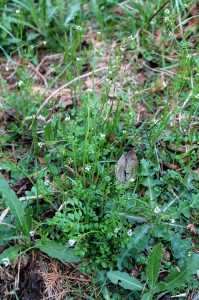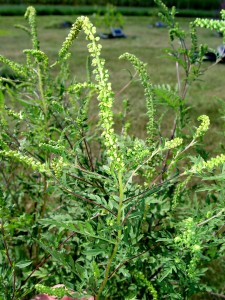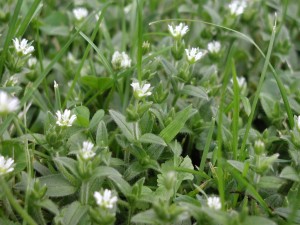Weedfest
April 17th, 2012
No, you’re not imagining things if it seems like weeds are worse than ever this year.
Part of it can be traced to the weather, which was great for germinating winter annuals like creeping veronica (the blue-blooming creeper), chickweed (the white-blooming creeper), purple dead nettle (the lavender-blooming upright with the square stem) and a relative newcomer, hairy bittercress (wiry stems with little flowers emerging from clusters of little leaves).
These not only got off to an early start but flourished in the warm soil. (For more on this, click here to see my latest weedy Patriot-News column.)
You might as well get used to this, though, because weed populations are up throughout the United States for a variety of reasons, according to the Weed Science Society of America.
Here’s a look at what’s been fueling this not-so-welcome trend:
Extreme Weather
The erratic floods and droughts that much of the country have been experiencing both can lead to worsening weed problems.
Flood water is one way weed seeds can move from one location to another, while wet soil is good for both weed-seed germination and subsequent growth.
On the other hand, drought can kill off planted lawns and gardens, opening the door to bare soil that’s often quickly re-colonized by opportunistic weeds.
Warmer Weather
Most noticeable to gardeners is the northward creep of weeds that previously died out in colder winters. Kudzu, for example, has now worked its way as far north as the Canadian shore of Lake Erie. And it even now flowers and sets seed in Pennsylvania, says Penn State weed scientist Dr. Bill Curran.
Harvard University scientists recently studied the plant life and temperature changes at Massachusetts’ Walden Pond, where Henry David Thoreau meticulously catalogued plants in the 1850s.
The scientists found that average annual temperatures are now 4.3 degrees warmer, a change that benefited species with the most adaptable germination habits and flowering schedules. Those species are primarily non-native and invasive ones that were not even present in Thoreau’s day, while 27 of the species that Thoreau saw were extinct.
Rising Carbon Dioxide
Along with warmer weather has come an increase in carbon dioxide in the air — a trend that research has found benefits weeds even more than ornamentals and crop plants.
Researchers at the U.S. Department of Agriculture’s Agricultural Research Service found that weeds growing in warmer urban settings with higher levels of carbon dioxide grew, on average, four times taller than the same species in country settings with cooler temperatures and lower levels of carbon dioxide.
Worse yet, common ragweed quadruples its pollen output when carbon dioxide levels double, suggesting increasing problems for hay-fever sufferers if the current trend continues.
An earlier study by USDA found that poison-ivy plants also have been growing bigger and developing more potent rash-causing oil in the last 50 years as carbon-dioxide levels have risen.
Ride-Hitching Weeds
A 2011 study by Montana State University researchers found that another underrated way that weeds spread is on the tires, bumpers, wheel wells and undersides of cars and trucks. That’s been an increasing problem as Americans have become more mobile.
The researchers counted weed seeds on vehicles and found that seeds from roadside weeds are readily picked up, especially in wet weather and in fall. The seeds often travel 160 miles before falling off. In cases where the seeds are caked in mud, they typically stay on until washed off.
ATVs and other off-road vehicles picked up 20 times as many weed seeds as on-road vehicles. The researchers concluded that frequent washing was the most effective way to control hitchhiking weeds.
Plant Stow-Aways
Yet another underrated problem is weed seeds spreading via plants bought in nurseries, stores and garden centers.
USDA researchers in Alaska bought more than two dozen plants from 29 different nurseries and then incubated the soil in a greenhouse to see what would sprout. They found 54 different species of weeds, especially chickweed, hairy bittercress, groundsel, La Plata sandspurry and Canada thistle.
They also found more weeds in balled-and-burlapped trees than potted flowers, more weeds in pots with soil-based mixes than soilless potting mixes, and a big difference between growers using good weed control and weed prevention vs. those not controlling weeds.
Bird Feeding
An unwanted side effect of the trend toward attracting birds to the backyard garden is more weeds — both on the feathers of the birds and in the seed that gardeners are buying for them.
Oregon State University researchers examined the weed seeds in 10 brands of retail wild bird seed and found that all brands had at least one species of weed. Half of them had six or more species.
The samples generated 50 different kinds of weeds, including 10 of Oregon’s most noxious invasives.
The researchers’ suggestions for bird-feeding weed control: use feeder trays to keep seeds from falling on the ground; buy baked or treated brands; be vigilant to prevent weeds and eliminate them early before they set seed, or stick with non-weedy food sources such as sunflower hearts, peanuts, peanut butter, raisins, mealworms and suet cakes.
Herbicide Resistance
One last concern with controlling weeds is species that are increasingly able to survive weed-killers. A function of evolution, the surviving weeds are passing along their herbicide resistance to offspring.
The Weed Science Society of America reports that ragweed, horseweed, johnsongrass and hairy fleabane are among the weed species becoming increasingly resistant to the widely used herbicide glyphosate (i.e. Roundup).
So as another weedy season unfolds, keep your diggers handy and your back in good shape.
It doesn’t look like we’re heading for any weed-easy seasons any time soon.










